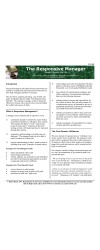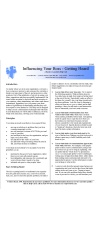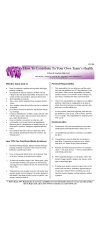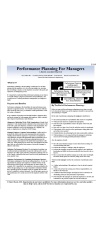Summary: Indepth and somewhat academic explanation of needs based conflict, a particular type of conflict.
Need-based conflicts arise due to multiplicity of needs, in congruency of needs and need dissatisfaction.
I. Multiplicity of Needs
At a given time one might wish to satisfy more than one need. The behavior that one need demands may be Incongruent to the behavior necessary for satisfying the other need, and one cannot behave in two different ways at the same time. This is similar to the desire to have more authority, but with less accountability or responsibility. Having power or authority is ego-satisfying. But being accountable or responsible creates feelings of insecurity. One cannot have power or authority without being accountable for it. However, it does not mean that a behavior cannot satisfy more than one need at a time For example, drawing a high salary could satisfy the physiological, security and status needs.
II. In congruency of Needs
Basically, needs by themselves can be conflicting. Satisfaction of one need entails foregoing the satisfaction of the other. Where both needs are equally important and are to be gratified immediately it could be very frustrating. For example, promotion in one’s job is ego- and status-satisfying and requires spending more time at work. This may overlap with family responsibilities and demands, fulfilling them being necessary for one’s comfort and happiness at home. The ensuing conflict is perhaps one of the causes for the increasing number of family separations or divorces happening in the present-day environment.
III. Need Dissatisfaction
When needs are dissatisfied, individuals get frustrated and frustration sets in the conflict process. Lack of promotion is most often a source of seriousness, where denial of promotion has resulted in negative and non-productive behaviors. Such a frustration could also result in psychosomatic disorders such as peptic ulcers high blood pressure and even coronary problems. The cases cited below reveal conflict experienced due to denial of promotion.
“After joining the security forces consequent to the completion of a short term commission with the Armed Forces, I put in about seven years of service In various difficult as well as semi-difficult areas. In a particular year, I had to serve under three different senior officers for a period of three to four months.. These officers, therefore, had written three separate ACR’s (annual confidential reports) of me. The grading by one officer, for a period of four and a half months that I worked under him, was average. Based on this report I was superseded by almost 18 officers who were junior- to me (at that time the reports of the other two officers had not been received). As there was no other solution to my super session, I remained silent and awaited for the other reports, trying to be calm and composed though it was very frustrating to me.
IV. Dilemma of choice
This refers to the pre-decisional conflict when an individual has to choose from a number of alternatives. The choice is limited to one. But he is unaware of the probability of attractiveness (or effectiveness) of the available alternatives in achieving the desired goal. The goal has high personal stakes; the choice of the right alternative in such circumstances is certainly conflicting.
The greater the feelings of uncertainty in a given situation, along with the fear that one may not be able to cope with or be able to control the situation adequately, the higher the frustration and conflict. Frustration due to uncertainty arises out of task/ goal ambiguity, job insecurity, changing nature of jobs, inability to predict outcomes or future events, power dynamics and office politics, and low interpersonal trust among role-set members. Lack of control over a given situation may be felt due to inadequate experience or skills, restrictions on behavior, time pressure, and poor relationships with others.
V. Work Environment & Conflicts
In a work environment, the sources of conflict are task and role-related. While task refers to a set of activities (as influenced by goals, objectives and procedures) minus the element of interpersonal interdependence, role refers to how these activities are actually performed in relation to other tasks, positions and people in the organizational network. Task-related factors that induce conflict are:-difficult and complex tasks that are perceived to be beyond one’s ability and tolerance level, insufficient work stimulation, as in the case of repetitive and monotonous tasks (tasks that are non-motivational), excessive stimulation resulting from work overload, and that too when one is psychologically unprepared for it, short time-limits for work completion, complex, unclear and incompatible rules, procedures and instructions, and real or anticipated fear of failure in one’s performance.
VI. Role as a Source of Conflict
How a role can be a source of conflict may be examined in view of the three basic ways in which ‘role’ may be defined.
Role in terms of its normative definition refers to a set of rights and duties associated with a position. Organizations divide complex tasks into specialized activities, assigning activities to particular roles which are coordinated to yield a final product or service. The patterns of activities that form a given role are determined by the physical and technological variables. These variables of the organizational design system impose the ways arid means of performing a role. The roles, primarily, are designed in the abstract by the experts and, later on, filled by individuals selected to fit the roles. The a priori established roles are presumed to be fixed and individuals are expected to fit themselves into these roles. Organizations specify in detail the obligations of a person who occupies a given role. These obligations include the tasks that must be performed to certain predetermined standards or criteria. The tasks are also qualified by various prescriptions and proscriptions relating to organizational rules, procedures and authority/responsibility relationships. Organizations ensure that the focal persons exhibit the organizationally defined role behavior through systems of positive and negative sanctions.
Conflicts arise when a role incumbent is not clearly aware of the rights and a duty associated with his role or has not properly learnt the patterned sequence of activities that relate to his rights and duties. Thus, the behaviors that are appropriate to his role may be undetermined and ambiguous for the role incumbent. Ambiguity can arise about:
– The scope of one’s responsibilities
– The limits of authority
– The rules and procedures, the sanctions and their applications
– The legitimate vs. illegitimate aspects of authority behavior.
Role as a social system includes the expectations of the members of the role-set which the role incumbent cannot ignore in performing his role. There tends to be a difference between the actual role behavior and the behavior determined by the organizational structure and design factors (such as authority, technology and work-flow demands). The apparent completeness of initial organizational design is somewhat a fiction. Perhaps, it provides a reference only and does not completely determine a role behavior. In other words, it provides only the anatomy, not the physiology (or the role process)of the organization. The pressures generated by others who have some vested interest in the way a focal person performs his job have to be taken into account. Those having vested interest include the immediate superior(s), subordinates and colleagues and other closely related (such as customers or suppliers) to the focal person’s work. They impose ways of performing a given task (or have expectations how the focal person has to perform the task) and at the same time rule out alternate ways. The superior(s) tend(s) to influence by the differential application of sanctions. The focal person’s ensuing behavior which is indicative of compliance or non-compliance is a feedback to the role-set members who accordingly either limit or maximize role pressures.
In this manner, a complex series of social interactions are assumed to occur that influence the behavior of the role incumbent. These interpersonal interactions can be formal and informal. When the expectations of the role set members that flood in. from various directions are incompatible, the focal person experiences conflict termed as ‘inter sender role conflict.’ Conflict occurs as complying with one set of role expectations makes it difficult to comply with another set of role expectations.
The case of Ms. Vijaya illustrates such a conflict situation. Ms. Vijaya was selected as a typist in XZ Company. In five years time she could acquire a qualification in shorthand. She was promoted and posted to the deputy personnel manager’s office as a stenographer. The deputy manager observed that her aggregate performance (typing and shorthand) was too poor to cope with her work in the office. He wished that she could be more efficient. But seemingly she remained unconcerned and did not improve at all. As a consequence, the deputy personnel manager was told by his superior (personnel manager) to demote her and transfer her back to her parent department. The deputy personnel manager was, however, unable to take any action because he came to know that Vijaya was related to the managing director. In his discussions with the managing director he got the impression that Vijaya should not be disturbed from her position. The deputy personnel manager was in a dilemma-should he act according to the instructions of the personnel manager and demote and transfer Vijaya to her parent department or follow the instructions of the managing director and retain her in the personnel department?
The psychological definitions of role takes into account the expectations and behaviors of the person who occupies a position. To this position, the occupant brings with him, as an outcome of an elaborate socialization process, a complex array of internalized beliefs, attitudes, values, norms and expectancies about himself and his physical and social environment. In his job he tries to integrate the required role behavior and his personal belief system. Incompatibilities between the two can ~ a source of conflict. When in compatibility is high, adjustment process may fail as the individual may not be able to modify adequately either the role demands or personal beliefs. In such a case, he may be psychologically less identified with his job (one’s self may move away from one’s ‘role’) and the job may not be perceived as contributing to his self-concept.
Intra-individual conflict is the likely consequence of such an incongruence between one’s beliefs and values and the value and belief orientation imposed by the organization. For example, an employee may be expected to get a job done by hook or by crook, which he finds incongruent with his own value system. The cases mentioned below also illustrate intra-individual conflict.
“I was appointed as the administrative officer of a national laboratory about two years ago, which position I lost due to the antagonism of the director. I was subsequently transferred to another place in a demoted position. Even though I was hardworking, devoted to my work and put forth my best efforts, I was transferred out in a treacherous way due to personal prejudice and not because of any of my shortcomings. It was all the more painful because of the manner in which it was carried out. I represented the matter to the headquarters, wherefrom I did not get any justice. It not only affected my career but also my value system. I often wonder if my personal value system is outdated in the way the present-day organizations are administered and managed. ”
After noticing a sufficient number of times that one of the employees came late to work, and after a few hours, absented himself from the work-spot, I made a report to my immediate officer. He advised me to strike off his name from the attendance roster for those days. Accordingly, I did. The employee, when he came to know about this came to me, picked up a quarrel and abused me and went away. The next day he came back with my boss who told me (in front of the subordinate) that he never told me to strike off the name of the employee from the attendance record and instructed me to give him attendance on those days. I marked him present and said sorry to the employee. This has not helped me in any way, but it has made me feel humiliated and at the same time spoiled my image.
VII. Task/Job Interconnectedness and Conflict Organization is a network of jobs at different levels.
These job positions are connected to each other as knots in a fisherman’s net, linked together sequentially, reciprocally or mutually. In sequential relatedness each job is connected to the other as in a chain. Work flows from A to B to C and so on. There is dependence of one on another, influencing task performance and a certain degree of role or task overlap. Conflicts arise due to this dependence and overlap in addition to jurisdictional ambiguities. One may assume more control over desirable activities or relinquish one’s part in the performance of less desirable activities or may even try to shift the undesirable activities to the role of others.
Such dependencies also exist in reciprocal coupling of jobs, where, for example, activities flow from A to B and then back to A. Thus, the output of A becomes the input of B and the output of B the input of A. Such a loop, giving rise to mutual role expectations and role demands, is a possible source of interpersonal conflict due to differences in one’s priorities or goals. Role dependencies between doctors and nurses in hospitals exemplify such conflicts.
When a number of job positions are linked to a single source (known as ‘mutual coupling’ or ‘pooled interdependence’) for drawing the necessary resources (the case of common funding), conflicts arise. Different divisions compete with each other for budget funds, space, supplies, supporting services, etc., to be obtained from a common point, i.e., the chief executive or the Board. Seldom are enough resources available on an integrative basis. Individuals may not get what they want and to the extent they want. Yet everyone tries to get the best advantage of the situation either for oneself or one’s group. Such competition is a source of interpersonal and interdepartmental conflicts. Generally, reciprocal coupling is likely to produce more conflict than sequential interdependence and the latter more than the pooled interdependence.
VIII. Line and Staff Conflicts
Line refers to the employees involved in some aspects of producing an organization’s product. (E.g. production, marketing), while the staff provide technical and advisory assistance or support to the line (e.g. purchasing, maintenance, quality control, etc.). The sources of conflict between the two are the differences in perspectives, status and goals. Generally, the staff managers tend to be better trained, more professional and younger than the line managers. On the other hand, the line managers are more experienced, and in senior position in the organization. The staff may go beyond their advisory role and exert control on the line manager’s activities which the latter resent as it undermines their authority. The line managers, in turn, complain of the staff advice as being theoretical, impractical and in vacuum. They allege that staff recommendations result in friction and loss of morale. In the future, as organizational technologies become more advanced and complex, staff vs. line conflicts are bound to increase.
IX. Conflict-prone Jobs
Some of the jobs by their intrinsic nature are conflict-prone as others are likely to resent the activities performed by the job-holder. Examples of such jobs are: collection agent of an insurance or finance company, investigator of departmental fraud, government tax auditor, etc. Organizational linking positions requiring integration and boundary spanning activities within the organizational hierarchy or across inter organizational boundaries are also conflict prone.
Mr. Amarendra.B.Dhiraj is a frequent speaker at internationally renowned global events, CEO/CTO/CIO Roundtables, Technology Conferences and Symposiums. He hosted and organized the Executive Technology Leadership Forum; the Theeurope Roundtable: Setting the market Value Through Globalization;the Leadership and Culture Change due to new Technology in current Markets; His latest article “Software outsourcing boundaries” was extensively appreciated and ranked into world top 20 research article of the year. He possesses strong leadership skills exemplified through his experience from International Business and Information Technology.
As CEO and cofounder of Aryan Hellas Limited, A.B.Dhiraj recognized the potential of the market and focused the company’s strategy on assembling a world-class technical team, addressing communication and project management issues.






